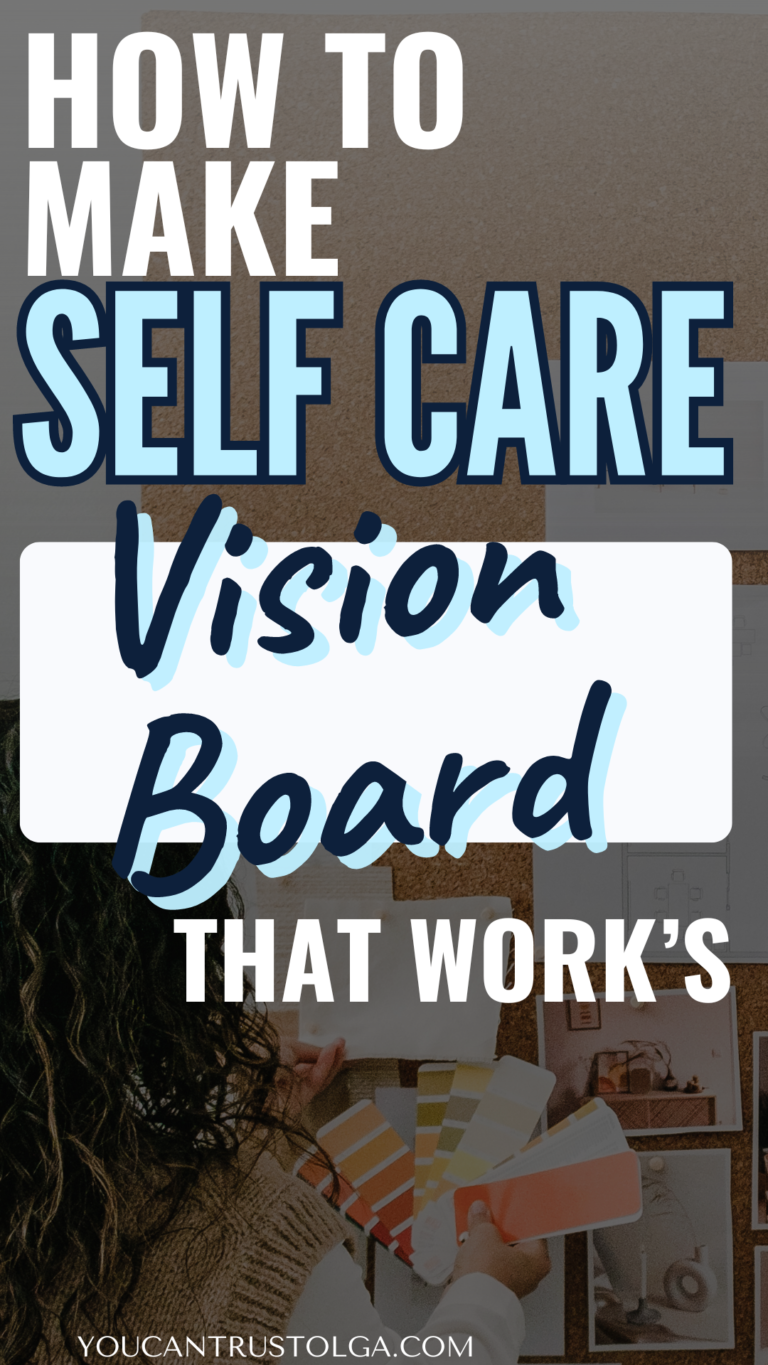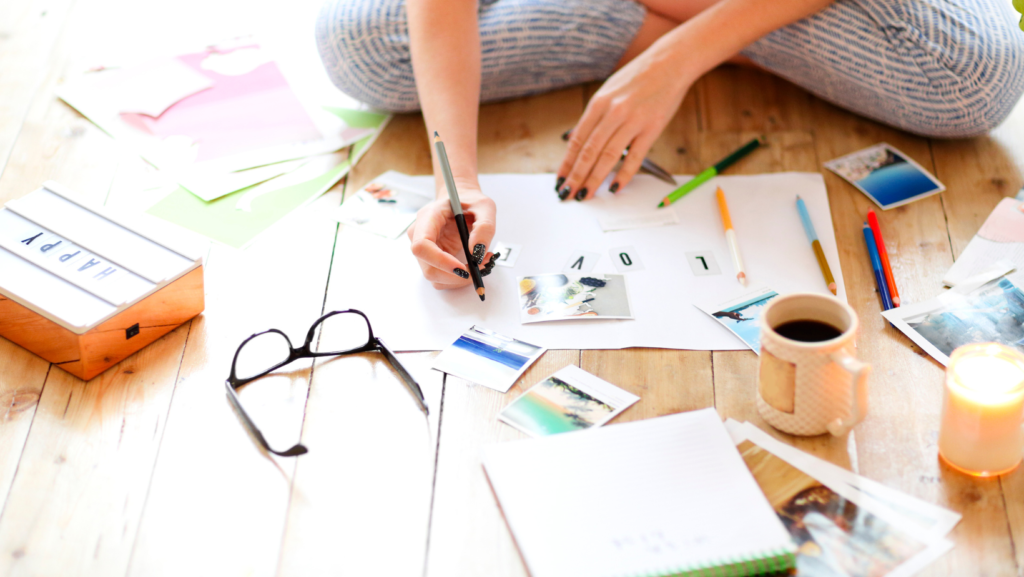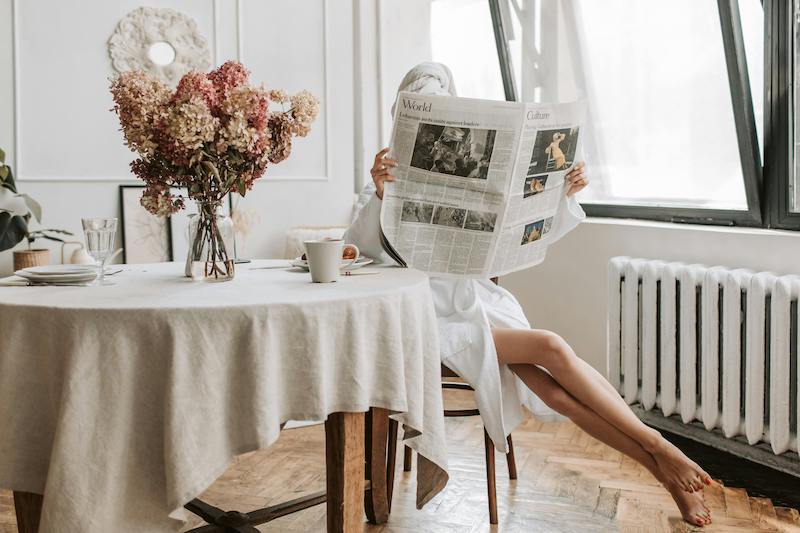Everyone is familiar with the concept of vision boards. These are physical or digital collages that help us visualize our goals and manifest them into reality. Most board’s themes usually revolve around career, relationships, health, and money. But what about creating a vision board for our personal well-being and making self-care our number one priority?
Because if we are real, self-care is where everything begins. It is like a foundation that supports all other aspects of our lives. In this blog post, I’ll share how to create an effective self-care vision board that lays the ground for a healthier and happier life.

What is a self-care vision board?
Let’s start by understanding what exactly a vision board is.
A vision board serves as a visual representation of one’s goals, dreams, and desires. It’s a dedicated space to collect and display inspiring images, quotes, affirmations, cherished photos, ideas, and more.
It usually serves as a reminder of your goals and is intended to keep you focused, especially at the moments when you feel like deviating from your path and going back to old ways.
Many people associate vision boards with manifestation tools. I don’t see why it can’t work in that direction. You can definitely use it for making a life of your dreams come true. Why not?
A self-care vision board is similar to any other vision board but with a specific focus on self-care goals. Instead of contemplating money dreams or travel desires, it serves as a means to gather and exhibit everything that motivates and inspires you to achieve your self-care objectives. Consider a self-care vision board as a wonderful companion to a gratitude list or journal.
Do vision boards work?
That depends on who you ask. Some people swear by it, claiming that visualizing their goals and desires helps them manifest them into reality.
Others are more skeptical and believe that simply creating a vision board is not enough to achieve one’s goals.
However, there is some research to support the idea of vision boards being effective in goal setting. A study published in the journal Psychology Today found that visualization can improve motivation and help individuals reach their goals. Another study from UCLA showed that visualizing an action or goal activates the same brain regions as actually performing the action.
But instead of just listening to what others say, why not give it a try and see for yourself?
How to create a self-care vision board?
Whether you have some experience in putting together visual boards or not, the steps below will guide you in creating a self-care vision board of real quality, the one that actually works.
1. Set Self-Care Goals & Look For Ideas
Take a moment to think about how you want to take care of yourself and what self-care means to you.
What parts of your life do you want to focus on? Is it your mental well-being or showing yourself some love? Maybe it’s your physical health and overall wellness.
Consider what’s important to you and create a vision board that ALIGNS WITH YOUR GOALS. Take your time with this process – there’s no rush to figure out all your life goals and self-care aspirations overnight.
A good exercise for that can be Free Writing – when you answer the journaling prompts by allowing your conscious flow without any filter. Because let’s face it – for many of us the hardest part is to actually understand what is it that we truly desire.
Here’s an exercise that can help you to get mental clearance on your goals.
SELF-EXPLORATION TECHNIQUE
Find a time and place where you won’t be interrupted or distracted. Give yourself at least an hour for the initial writing, but if you prefer, you can split it into three separate sessions. You can always do the analysis later. In fact, it might even help to come back to what you’ve written with a fresh eye.
Spend a minimum of 20 minutes on each section, with no maximum time limit. Just let the words flow. Don’t worry about going back to edit or planning what you want to say.
Let’s begin with the “My Ideal Self” section. Imagine yourself in a scene that’s not bound by reality. What are you doing? Where are you? Who else is there with you? Feel free to include all the tiny details, like what you’re wearing or the background sounds. Your dream version of yourself can be anything you want, but it doesn’t have to be something extreme. Not everyone dreams of owning a tropical island after winning the lottery. What do you truly want for yourself a year from now?
Next up is the “My Probable Self” section. Write about a scene that includes you, but this time, let reality come into play. Maybe it looks similar to your current situation, or maybe things have changed in a year. What do you expect for yourself a year from now?
Lastly, we have the “My Feared Self” section. This one can be a bit scary. Describe a scene where your worst nightmares become a reality. Remember, our fears aren’t always rational, so don’t limit yourself to what’s likely to happen. What are you most afraid of becoming a year from now?
Analyzing what you have written can give you amazing insights into your goals, desires, and fears. It can also help you map out a plan to achieve the life you truly want for yourself.
2. Ask yourself Why you want It
This may seem like a simple question, but it’s important to dig deeper and truly understand the motivation behind your desires. Is it for personal fulfillment, emotional stability, or societal expectations?
We often want something because we saw someone on social media doing that and we think it will make us happy. But will it truly bring you long-lasting happiness and fulfillment?
Don’t allow yourself to be merely a copycat.
Understanding the why behind your goals can help you clarify and prioritize what’s truly important to you.
3. Decide on a vision board type
Once you have filtered and set your goals, it’s time to determine the method and location for creating your vision board. You have a few options to choose from.
You can go for a physical vision board made of poster board or corkboard. You can fill it with images from magazines, and papers, along with handwritten notes and postcards.
A physical vision board can sound a little dated, BUT. Creating a vision board with your hands is a form of therapy.
Not only you are can emerge yourself in the creative process, but doing physical manipulations with your hands is proven by psychologists to release stress and negative emotions. It is an amazing way to be present and give your mind a mental break.
VISUAL BOARD SUPPLIES YOU NEED TO MAKE A BEAUTIFUL BOARD
The variations of tools and supplies you can use for a visual board are enormous. Here your creativity has NO LIMITS – it is your project now and you are the artist.
There is also no time limit and you can take as long as you need to complete your composition. Actually taking it slower and longer will allow you to become personal with each piece you put in there and thus make it more meaningful.
Some of the essential supplies you may want to consider for creating a beautiful visual board include:
- Poster Board or Cork Board – These are the most common bases for a visual board. It’s important to choose a size that fits your space and allows enough room for all your ideas. You also want it to be strong enough to hold all your materials and decorations.
- Magazines, Newspapers, and Printed Materials – Cut out images, words, and phrases that resonate with you and represent your goals or intentions. Don’t limit yourself to just one type of magazine, explore different genres to find inspiration.
- Colored paper and cardstock – These are great for adding pops of color to your visual board and creating contrast. You can also use them as backgrounds for images or to write on.
- Scissors and glue – These basic tools are necessary for cutting out images and attaching them to your board.
- Washi tape – This decorative tape comes in various patterns and colors, making it a fun addition to your visual board. You can use it to frame images or create borders.
- Stickers and embellishments – These can add an extra touch of creativity to your board. Look for stickers that represent your goals or intentions, or use them to accent certain images.
- Quotes and affirmations – Cut out words or phrases that inspire you and align with your goals. You can also write out affirmations on colorful paper or index cards to add to your board.
- Small containers and pockets – These can be attached to your board to hold items such as pens, pencils, or small motivational cards.
- Ribbon or twine – Use these to create a hanging display for your visual board. You can also use them to divide sections of the board or attach smaller images.
- Post-it notes – These are perfect for adding reminders or writing down specific tasks related to your goals. You can easily move them around on your board as needed, so they can make your physical board more dynamic.
- Paper clips and push pins – These tools are essential for attaching heavier or bulkier items onto your board, such as newspaper clippings or magazine pages.
- Markers, colored pencils, crayons, and paint – These can be used to add personalized touches to your visual board, whether that’s highlighting important words or adding doodles and drawings.
- Personal items – Don’t be afraid to include personal items on your visual board that hold special meaning to you. This could be a trinket from a memorable trip or a photo of loved ones
Alternatively, you can create a digital vision board using tools like Canva or Pinterest. With a digital vision board, you can gather inspiration and images from anywhere on the internet to create a self-care vision board.
Personally, my favorite option is to create a digital vision board using Canva. It offers a wide selection of stock photos, graphics, GIFs, and patterns that you can use to design your vision board.
They also provide numerous self-care vision board templates. Moreover, Canva has a variety of beautiful fonts to help you personalize the board and add your own quotes and messages.
Pinterest is also an excellent platform to find vision board templates and examples that can inspire you.
Additionally, for more digital materials you can go to stock image websites like Pexels, Pixabay, or Unsplash where you can find and borrow photos ABSOLUTELY FREE.
4. Assemble and Reflect on Your Vision Board
After identifying the elements to include on your vision board, it’s time to bring it all together. Get your poster board or digital canvas ready and start assembling your ideas.
Combine images, quotes, affirmations, photos, textures, patterns, and colors to craft a self-care vision board that sparks inspiration and fuels your motivation to pursue your self-care goals.
Your self-care vision board shouldn’t be a “make it and forget it” affair. Remember to revisit it regularly to fully appreciate its value – a daily source of inspiration for your self-care dreams and goals.
Don’t forget to make changes and updates over time, ensuring that it remains a dream board and not a “what I used to dream for” board.





